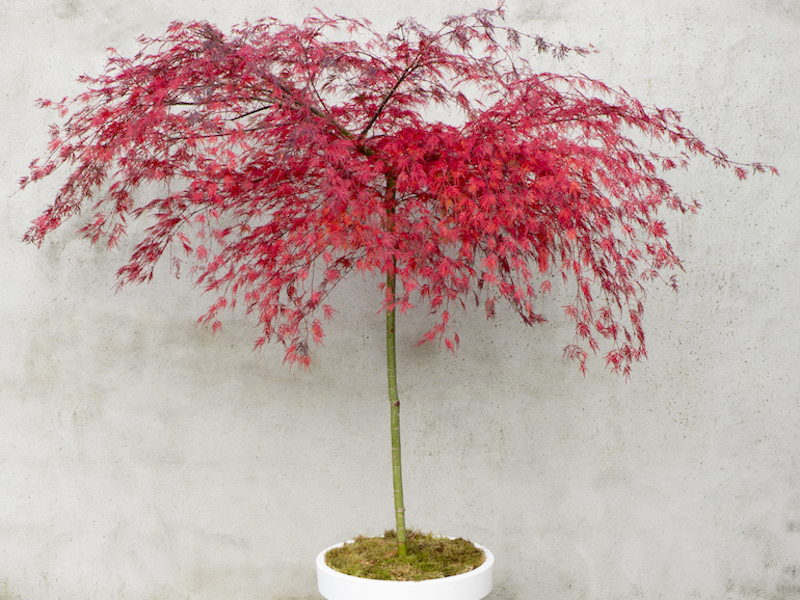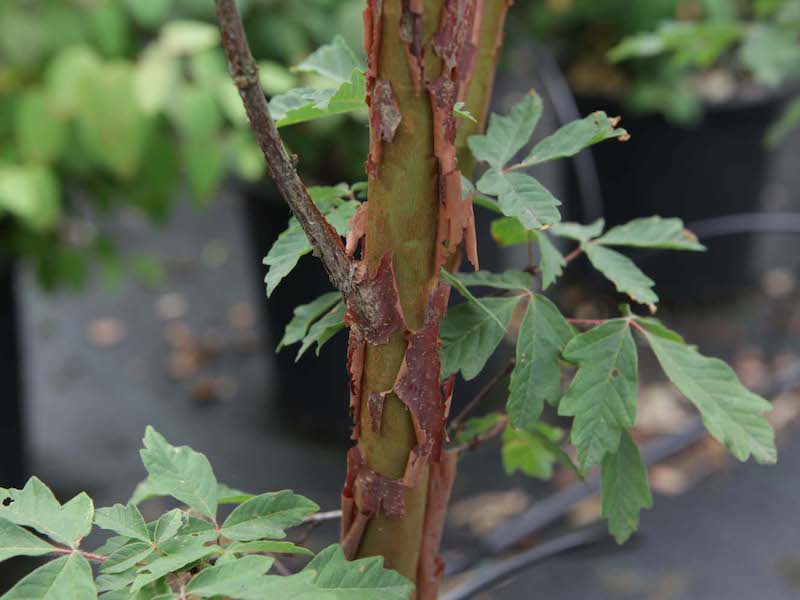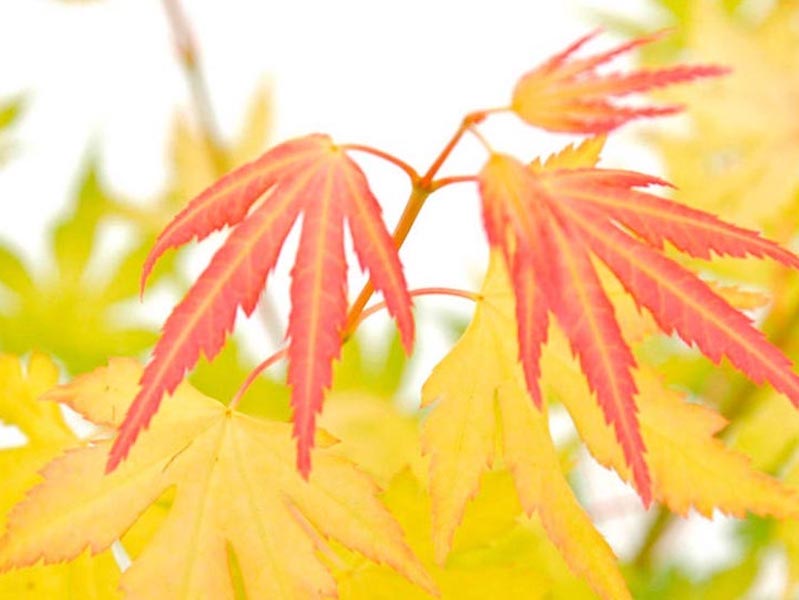The beautiful colour and form of a Japanese maple or acer will enhance any garden, and there’s a huge variety to choose from. Slow growing acer trees or shrubs make a stunning statement with their eye-catching autumn foliage, but their ornamental leaves and stems look striking almost all year round. To help you choose, plant and care for acers, we’ve searched the internet to collate a wide range of independent, expert advice. Check out these articles, YouTube videos and social posts for everything you need to know.
Contents
- Best advice on where to grow acers
- Best advice on growing acers in containers
- Best advice on choosing the right acer
- Best advice on caring for acers
- Best advice on pruning acers
Best advice on where to grow acers

Image: Acer ‘Garnet’ from Suttons/Copyright: Branded Garden Products
Native to Japan, acers are staples of the classic Japanese garden, giving the look of a mature tree but without the size. Garden Ninja Lee suggests planting acers as part of a calming Zen space that aims to echo nature. He adds that Japanese maples are great for screening the bits of your garden you’d like to hide, or for defining areas set aside for quiet or meditation.
@naomisladegardening, getting the best effect from your acer is all about where you position it. Naomi loves the contrast of bright and snazzy red acer foliage against the fresh green of ferns in this photo. Planting these small, slow growers on a raised mound is a great way to elevate the stature of your Japanese maple, as Naomi appreciated on a visit to Wildside garden in Devon.
Another fan of using acers in a Japanese inspired garden is Dan of The Frustrated Gardener. He highlights a stunning design by Kazuyuki Ishihara for the Chelsea Flower Show where contrasting maples are used with other shrubs to frame the space around a rugged rocky pool and octagonal garden house.
Waxing lyrical about their versatility, Kirsty of Get Planting! aptly describes acers as living sculptures with a wealth of forms and textures. Warning that planting one Japanese maple in your garden might get you addicted, she suggests positioning one specimen as a stunning centrepiece or planting acers at intervals in a border.
A good starting point is to find your acer a nice sheltered spot, says Alexandra of The Middle Sized Garden, warning that Japanese maples aren’t keen on very sunny or windy gardens. She reveals that they prefer a neutral to acid soil; if your garden doesn’t tick that box, you can always grow them in a pot with ericaceous compost.
Best advice on growing acers in containers

Image: Acer palmatum plant ‘Emerald Lace’ from Suttons
Singing the praises of a pot-grown acer, and picking them as one of his four top choices for container trees, Mr Plant Geek, aka Michael, reminds us that Japanese maples have lovely, but delicate, foliage and prefer a shady position out of the wind. They do best in soil that’s kept moist, too.
Sharing a photo of a glorious orange acer in a bright blue pot on her patio, Blooming Lucky’s Louise Findlay-Wilson advises choosing a container to complement your acer’s colouring. She loves the contrast between the two opposite sides of the colour wheel.
For a comprehensive look at choosing the right container for your acer, check out the top picks of enthusiast Dave at Garden Focused. He recommends planting your Japanese maple in a stone or terracotta pot because they’re sturdy and won’t get blown over easily. He stresses it’s best to use ericaceous compost, or a loam-based one that’s slightly acidic.
Best advice on choosing the right acer

Image: Acer griseum plant from Suttons
With foliage hues that progress from lime green through burnished orange to a rich yellow, even when the leaves drop the acer’s vivid deep pink bark and stems look great through the winter. Outlining the wealth of acers available in his article: The Magic of Garden Maples, Alan at Down to Earth recommends a couple of stunners that will grow well in containers. For a real showstopper, he selects the award-winning, compact Acer palmatum ‘Katsura’, with lobed leaves that are orange when they unfurl. He also picks Acer palmatum ‘Garnet’ for its distinctive, finely dissected, purple leaves.
Two varieties that Simon at Garden of Eaden finds particularly attractive are Acer palmatum ‘Bloodgood’ and Acer ‘Griseum’. He describes ‘Bloodgood’ as a largish acer with deep purplish red foliage, small purple flowers in spring, followed by red, winged seed pods and leaves that turn a brighter red in autumn. By contrast, it’s the trunk of the ‘Griseum’, also known as the Paperbark Maple, that’s the star. When mature, its reddish-brown bark peels away, exposing cinnamon-coloured under-bark.
Recommending acers for all year round interest in modest spaces, Rajul at The Small Gardener also selects Acer ‘Griseum’ for its tactile peeling bark and colourful foliage. She describes it as a rounded, slow-growing tree that does well in most well-drained soils.
Lewis from @iplantsman helpfully runs through different types of acer by habit, leaf and colour, and reveals that you can even grow a beautiful and effective acer hedge. He says the variety Acer Campestre (or the field maple) is particularly suited to this role, with thick green foliage turning delicious, buttery yellow in autumn.
Another vote for the Acer Campestre comes from Andrew at Gardens, Weeds and Words, but he names his standout favourite Japanese maple of the moment as Acer palmatum ‘Sangokaku’.
Best advice on caring for acers

Image: RHS Images Collection
Japanese maples are thirsty trees and won’t like it at all if their roots dry out, says Keith Beard. His thorough video on watering pot-grown acers takes you through exactly how to keep them well hydrated. Make a puddle on the top, let it soak through and drain, then repeat. You’re not drowning the tree, you’re keeping the compost damp. In the summer, he says it’s best to get someone to water your potted acers if you’re going to be away more than three or four days.
Watch out for pests and diseases attacking your acer, or they could start destroying its leaves and branches, warns Catherine at Growing Family. She also advises paying attention to the soil your tree is planted in, checking for nutrient deficiencies. On another note, if you want to make use of your falling Japanese maple leaves, you could follow the Osaka tradition and deep fry in batter as a seasonal delicacy!
Acer leaves can be prone to scorching in excessively sunny or windy positions, according to Tejvan at Gardener’s Tips in his excellent article: Problems with acer palmatum. And if you’re growing them in a container, they could be troubled by vine weevil larvae, scale insect damage or the fungal disease verticillium wilt.
Best advice on pruning acers

Image: Acer palmatum plant ‘Little Princess’ from Suttons
To keep your acer tree or shrub in good shape, it’s a good idea to prune it occasionally. Ian at DIY Home and Gardening says the best time is when the worst winter weather is finished. His step-by-step video guide, How To Prune Japanese Acers, runs through the process, starting with trimming off the dead, lighter sections of plant stem.
Tony and Marie at Four Seasons are veritable experts in the art of pruning Japanese maples. With more than 125 acer shrubs and small trees growing in their fabulous garden for over 20 years, they keep them all to the limited height and width they prefer by pruning regularly in winter when they’re dormant.
As colourful stars of the small tree and shrub world, acers are hard to beat, whether you plant them in the border, as a standout feature of the garden, or in a beautiful container on the patio or balcony. Heed the advice of the experts and you’ll soon find the perfect acer for you.
Lead image: Acer palmatum plant ‘Orange Dream’ from Suttons
Last Updated on February 10, 2025 by Suttons Horticultural Team






Will I be able to prune my acer now ? As it has lost most of it’s leaves .
Kind regards
Firstly, I don’t advise hard pruning of Acers. They are renowned for their elegant shape which is ruined by hard pruning and once pruned their beautiful form can never be recovered. It sounds as though this tree was simply too large for its position. It is hard for me to diagnose the cause of your tree’s problems, although Acers are prone to verticillium wilt which can cause ugly brown lesions in the truck and branches as well as premature leaf drop. Heavy pruning may have exposed the tree to pathogens or simply stressed it out. If it fails to recover, I advise replacing it with a more suitably sized tree although it would be wise to send a sample of the root to the RHS advisory service to ensure that it hasn’t been attacked by fungal pathogens which would spread to any newly planted specimen.
Hi,
I have a large Acer that is about 15 years old. I pruned it quite had in 2020, in 2021 it grew but by summer it’s leaves turned brown and fell like autumn. I have noted on the bark it’s split and damaged and there are deep grooves in it, but I have seen no pest like squirrels on it. This year it did the same loads of buds, grew nicely but by June went brown and leaves fell. I have had a problem with fungus killing shrubs but it usually wipes them out in a few weeks. I don’t know whether to remove it or try help it. It has fresh buds so seems a shame to take it out?
Please help!
Bob unwin
I have a young Acer about three feet high it became covered with other flowers this year anf now i see it is dark green could it be lack of light
My Acer tree this year has only grown leaves on one side at the top no where else now they have all fallen off the bark is starting to peel of in places
Would you have any advice to why or is the tree on its last legs
Regards Colin
Hi Penny, we are pleased to hear your acers are doing well and we hope you enjoyed the blog.
Best regards,
The Suttons Team
I love watching DIY Home & gardening both on IG & YouTube. Ian has helped me out loads of times with answers to my many questions & my Acers have never been better.